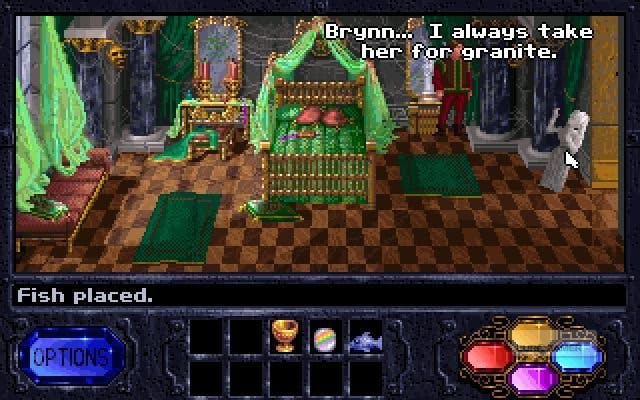Retrospective: The Legend of Kyrandia: Book One
Everyone called Malcolm is evil.
A long running joke in the genre has always been the infinite pockets of your character, but here you had ten slots and that was it.
However, you were also able to drop objects. These would stay on the screen wherever you left them, so you had to choose what to take with you on any excursion.
Which was idiotic. Knowing which items to take with you as you walked 40 screens away required psychic powers. The inevitable traipses back offered not a jot of joy. Things got particularly tedious when stranded in the network of caves so generously provided.
The whole game requires mapping if you're to have any chance of avoiding aimless wandering. Which is something I haven't done for years.
Completely lacking squared paper I resorted to actually printing some out. Then, just as my father taught me, I began drawing squares for each location.
Westwood's game faithfully allows this, not resorting to the silly looping forests or randomly generated exits that frustrated in so many of the adventures at that time.

But the caves - the dark gloomy caves - required that you light you way with fireberries. Each berry could be moved no more than three locations before burning out, and stepping into darkness meant instant death.
The process of mapping and lighting the labyrinth is certainly an elegant logic problem, if one of the most tiresome events I've experienced.
But it turns out mapping makes everything OK! What a remarkably satisfying process that is. In fact, thanks to my complete lack of a sense of direction (I get lost going upstairs) I mapped the entire game.
As much as some of the utterly idiotic puzzles may have annoyed me, looking at that pile of paper brings me the sense of satisfaction that Anaximander must have felt as he completed his first map of the world.
It's strange that Kyrandia is so forgotten. There were three of them, to start with (only while replaying the first did I remember it's the second one - Hand Of Fate - I really liked).
Not only did the game innovate with its cursor, inventory and the (massively underused) spells the amulet offers, it was also an absolutely beautiful game.

The painting is gorgeous, far ahead of the detail others were offering in '92. The animation is remarkable, the characters far more vivid and alive than you'd expect for the time.
Westwood is a studio famous for being remarkably good. Few have forgotten its most famous adventure, the troubled and brilliant Bladerunner. So why did the Kyrandia series slip through the cracks?
I'd venture possibly because it was so similar to King's Quest, despite being not nearly so insufferably smug. Westwood is a studio which will always be (rightly) remembered for Dune II, Command & Conquer, Eye Of The Beholder and Lands Of Lore (what a résumé!).
But while Kyrandia unquestionably makes some of the worst mistakes of adventures at that time (it was a year before LucasArts would convince the rest of the world that killing your character was a bad idea), it also offers some smart writing, a few nice puzzles and a bunch of daft imagination.
However, I'd prefer it if people could continue to forget about it, so my rant about the degradation of adventure controls can continue. Thanks.








